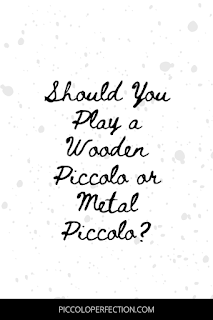Piccolo Flute Specs: How to Buy a Piccolo
Are you searching for the perfect piccolo? You should know about some common piccolo flute specs and why they matter.
Then, you can use that information to help shop for the right piccolo for you. Whether you need your first piccolo or an upgrade, specs can make a huge difference.
Before we get into the details, this post contains affiliate links. Click here to read the full disclosure policy.
Materials
The first of the piccolo specs to consider is the material of the instrument. Piccolos can come in various materials, which can affect their sound, including:
- Metal
- Plastic
- Wood
- Wood-plastic composite
Metal piccolos are excellent for playing outdoors or in a large ensemble. Their sound can carry very well, so you'll be easy to hear.
Plastic piccolos are also useful for playing outdoors. But they're also useful for playing inside because they can blend well with other instruments in an orchestra.
Wood piccolos are the most expensive, and you should only play them inside, if you can. The wood can crack in extreme temperatures and humid conditions.
Composite piccolos are a nice compromise between plastic and wood. They have a similar sound to wood, but they won't crack because of the plastic content.
You can also get a piccolo with any combination of materials between the headjoint and body. Many students start on piccolos with metal headjoints and plastic bodies, for example.
Split E Mechanism
One of the best piccolo flute specs is the split E mechanism. Now, it only improves the sound of one note, the E above the treble clef staff.
However, that note can be hard to play without cracking the pitch. It's hard enough on the flute, and it's more tricky when playing the piccolo.
The mechanism works by splitting the two keys that you close to play G natural. Normally, the two keys open and close together, but the split E mechanism allows the lower key to close.
That way, only one key is open when you play the third octave E. The change lets you play that note more smoothly.
G# Facilitator
A less common spec is the G# facilitator, and as far as I know, it's only available on Hammig piccolos. Like the split E, this mechanism only affects one note.
But it makes playing the G# an octave above the staff much easier. You don't have to worry about using alternative fingerings to get the note to sound in tune.
Because it's not that common, it's not necessary. However, it's a nice feature to have, especially if you're already interested in Hammig piccolos.
The entry level 650/2 model doesn't have the feature. Fortunately, you don't have to pay that much more for the 650/3, which has all of the same specs plus the G# facilitator.
G-A Trill
Some piccolos feature a G-A trill key that makes it easy for you to trill between high G and high A. That trill can be difficult on the flute as well, and the spec is available on that instrument, too.
On the piccolo, having a G-A trill key can come in quite handy if you play high notes a lot. I don't have any piccolos with this spec, so I don't know for sure how helpful it is.
However, it's probably one of those things that you can't live without once you try it. If you're looking for a professional piccolo, you can probably find one model with this feature.
Unfortunately, most beginner and intermediate models don't have a G-A trill key. So you'll have to wait and save up if you want to get the key.
Bores
Most piccolos today have a conical bore, meaning the end of the piccolo is smaller than the tenon that connects to the body. This is the same bore style that older flutes had.
You can find a conical bore on most wood and plastic models. The one exception to this is the Nagahara Mini piccolo, which has a cylindrical bore.
A cylindrical bore is shaped like a cylinder, so both ends are the same size. That's the same bore as the modern metal flute, and you can find it on most metal piccolos.
Neither bore is inherently better or worse. You should try piccolos with both designs to determine if you like one over the other.
Headjoint Cuts
One of the piccolo flute specs that gets people talking is headjoint cuts. The headjoint cut refers to the shape of the hole that you blow into on your piccolo headjoint.
Traditional headjoints have a round embouchure hole, and they're traditional. You can probably find the shape on piccolos from decades ago.
But wave cut headjoints are becoming more popular. The wave shape is a bit more rectangular, and it includes a slight adjustment to the opposite side of the hole from where you blow.
That shape can help you get your air into the headjoint of the piccolo. It's useful for beginners, but some serious players (like myself) prefer the style over the traditional cut.
You can also find piccolos that have lip plates, which are almost always available on metal models. But some wood and plastic piccolos have a carved lip plate.
That can make the instrument feel easier for new or casual piccolo players. I've never noticed a huge difference when trying piccolos with that style, but you may like it.
How to Buy a Piccolo
Now that you know about some common piccolo flute specs, you may wonder how you can buy one. The right piccolo for me may not work for you.
Fortunately, there are a few steps you can take to choose an instrument that you will enjoy playing.
Consider Your Budget
The most important factor to think about is money. If you don't have the money, it won't matter how much you love a piccolo.
Some piccolos cost less than $1,000, but others top $10,000. So set a budget for yourself and think about how much money you're willing to spend on a piccolo.
As a beginner, $1,000 is plenty to offer you a good selection of choices. Intermediate piccolos cost $1,500 to $3,000, and pro instruments start at around $3,500 or $4,000.
Determine Your Needs
When thinking about your budget, consider what you need or want in a piccolo. Do you want to play it outside? Inside? Will you play it in an ensemble or solo? Both?
While wood piccolos can sound great, they aren't the best for outdoor use. So you may want to get a plastic or composite model to still get a sweet sound without the risk of the wood cracking.
You should also decide if you need a particular spec, such as the split E mechanism or a headjoint cut. Then, you'll be able to narrow your search for the best piccolo.
Review Piccolo Specs
Speaking of specs, be sure to check them out with each piccolo that you try. Specs can play a big role in choosing the right instrument for you, especially the headjoint cut.
When I was testing piccolos before buying my current one, I played two from the same brand. Each had a different headjoint cut, and I even switched them with the bodies.
After that, I knew that one of the headjoint cuts was a much better fit for me. You may prefer that you sound the best on a piccolo of a specific material, or you might want a special key.
Try a Few Piccolos
Once you have an idea of what you want, try as many piccolos as you can. Ideally, you should try at least three to five models.
That way, you can test a variety of brands to see which you like the best. You can test piccolos at a music store, a flute convention, or online through an in-home trial.
Or you can buy a piccolo from a store with a return policy. If you like the piccolo, you can keep it, but you'll be able to return it if you don't like the model you buy.
Play the Same Music
As you test out different piccolos, use the same exercises and pieces in your trial. If you play different things on the piccolos, it will be harder to figure out which is the best option.
When you play the same pieces across instruments, you can focus on how each instrument feels and sounds. Then, you won't have to think about as much when making your choice.
Be sure to choose music that covers the entire range of the instrument. And use a tuner to see if one piccolo is more or less in tune than the others.
Use Earplugs
If you want to protect your ears, you should use earplugs when playing the piccolo. So do the same when trying piccolos out to give you an idea of how the instruments sound in practice.
You can record yourself and listen back without earplugs to hear how the models sound that way. Or you can have someone play each piccolo for you while you listen live without earplugs.
Then, you'll know how each piccolo sounds to others. If you're trying to choose between two instruments, that may help you decide which to buy.
What Piccolo Flute Specs Do You Need?
The best piccolo flute specs for me may not be the same as for you. That's okay! But with all of the options available, you should consider your preferences.
That way, you'll be able to choose the piccolo that best suits your needs. And you can avoid buyer's remorse AND have an instrument you'll enjoy playing for years.




Comments
Post a Comment